battery capacity SSANGYONG KORANDO 2012 Service Manual
[x] Cancel search | Manufacturer: SSANGYONG, Model Year: 2012, Model line: KORANDO, Model: SSANGYONG KORANDO 2012Pages: 1082, PDF Size: 96.1 MB
Page 215 of 1082
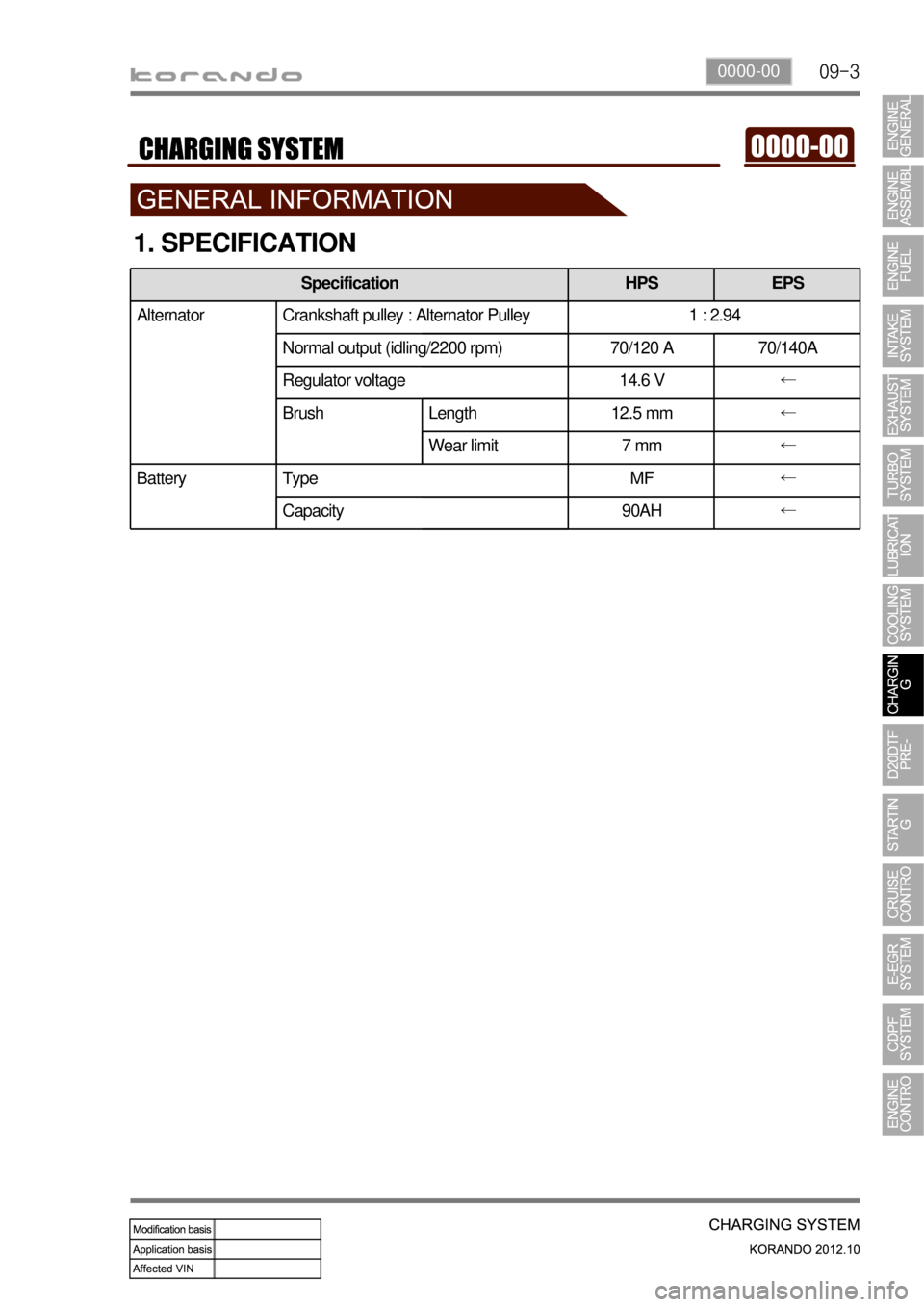
09-30000-00
1. SPECIFICATION
Specification HPS EPS
Alternator Crankshaft pulley : Alternator Pulley 1 : 2.94
Normal output (idling/2200 rpm) 70/120 A 70/140A
Regulator voltage 14.6 V←
Brush Length 12.5 mm←
Wear limit 7 mm←
Battery Type MF←
Capacity 90AH←
Page 219 of 1082
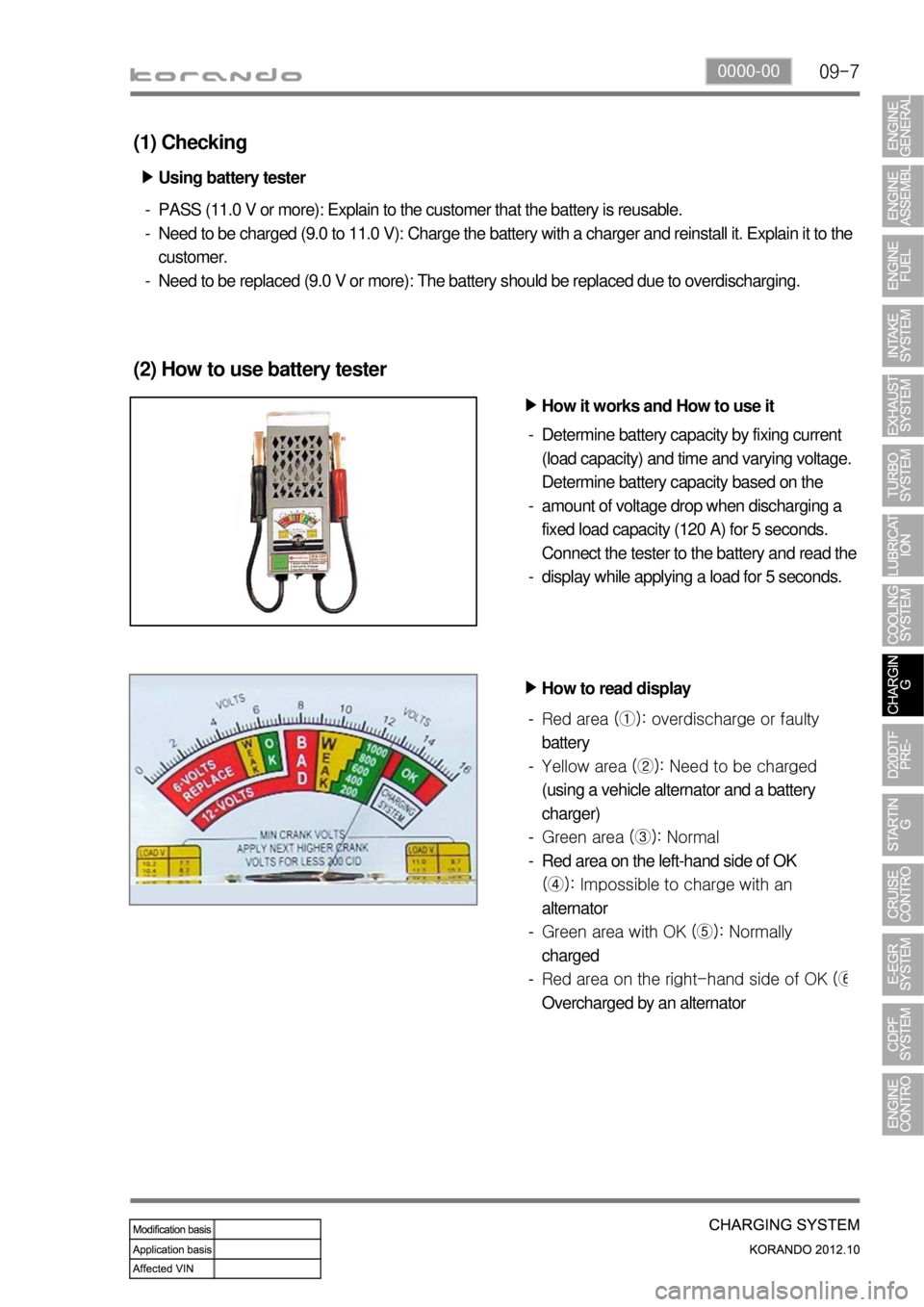
09-70000-00
(1) Checking
Using battery tester ▶
PASS (11.0 V or more): Explain to the customer that the battery is reusable.
Need to be charged (9.0 to 11.0 V): Charge the battery with a charger and reinstall it. Explain it to the
customer.
Need to be replaced (9.0 V or more): The battery should be replaced due to overdischarging. -
-
-
(2) How to use battery tester
How it works and How to use it ▶
Determine battery capacity by fixing current
(load capacity) and time and varying voltage.
Determine battery capacity based on the
amount of voltage drop when discharging a
fixed load capacity (120 A) for 5 seconds.
Connect the tester to the battery and read the
display while applying a load for 5 seconds. -
-
-
How to read display ▶
Red area (①): overdischarge or faulty
battery
Yellow area (②): Need to be charged
(using a vehicle alternator and a battery
charger)
Green area (③): Normal
Red area on the left-hand side of OK
(④): Impossible to charge with an
alternator
Green area with OK (⑤): Normally
charged
Red area on the right-hand side of OK (
⑥
Overcharged by an alternator -
-
-
-
-
-
Page 223 of 1082
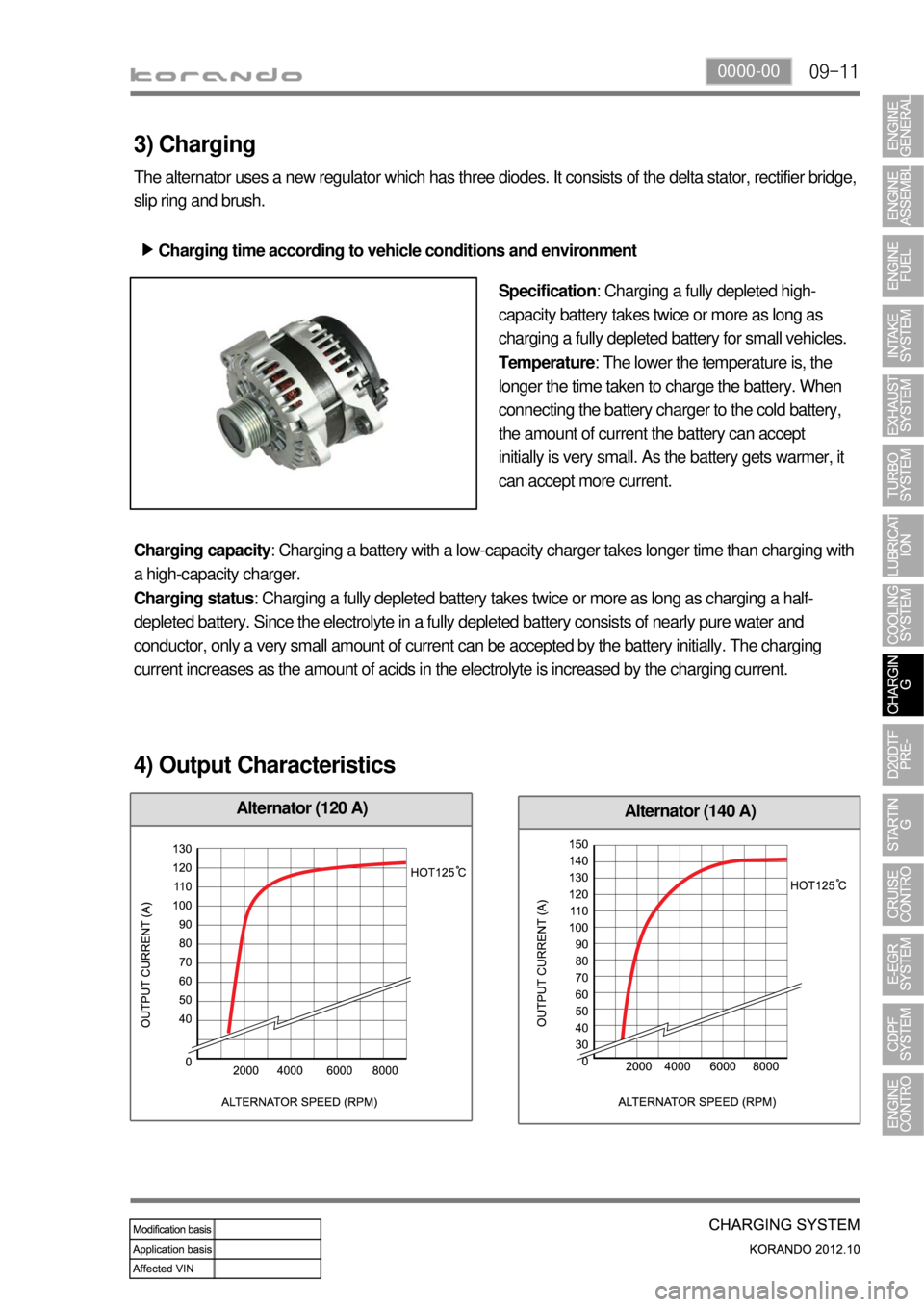
09-110000-00
Alternator (140 A)Alternator (120 A)
3) Charging
The alternator uses a new regulator which has three diodes. It consists of the delta stator, rectifier bridge,
slip ring and brush.
Charging time according to vehicle conditions and environment ▶
Specification: Charging a fully depleted high-
capacity battery takes twice or more as long as
charging a fully depleted battery for small vehicles.
Temperature: The lower the temperature is, the
longer the time taken to charge the battery. When
connecting the battery charger to the cold battery,
the amount of current the battery can accept
initially is very small. As the battery gets warmer, it
can accept more current.
Charging capacity: Charging a battery with a low-capacity charger takes longer time than charging with
a high-capacity charger.
Charging status: Charging a fully depleted battery takes twice or more as long as charging a half-
depleted battery. Since the electrolyte in a fully depleted battery consists of nearly pure water and
conductor, only a very small amount of current can be accepted by the battery initially. The charging
current increases as the amount of acids in the electrolyte is increased by the charging current.
4) Output Characteristics
Page 313 of 1082
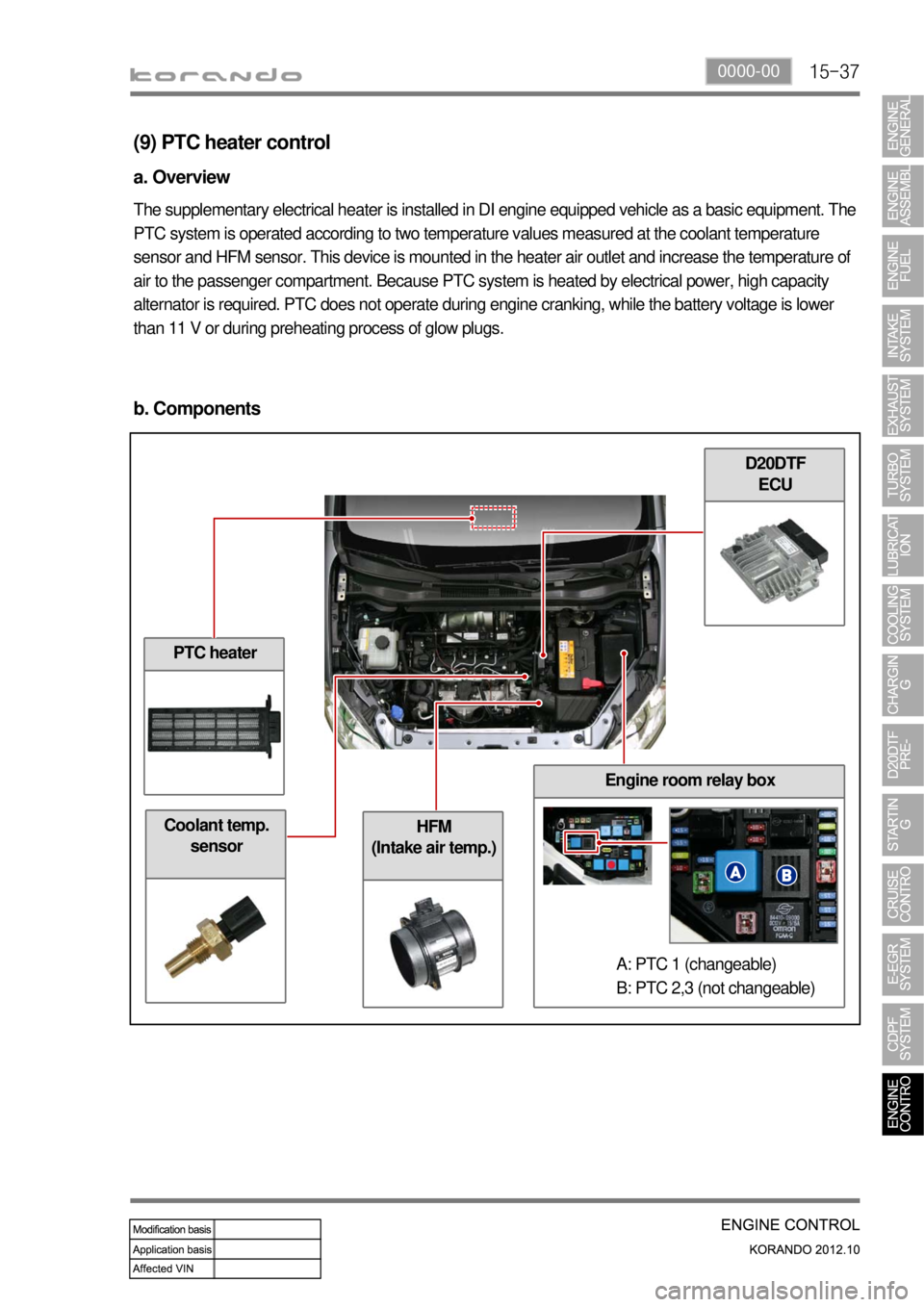
15-370000-00
HFM
(Intake air temp.)Coolant temp.
sensor
(9) PTC heater control
a. Overview
The supplementary electrical heater is installed in DI engine equipped vehicle as a basic equipment. The
PTC system is operated according to two temperature values measured at the coolant temperature
sensor and HFM sensor. This device is mounted in the heater air outlet and increase the temperature of
air to the passenger compartment. Because PTC system is heated by electrical power, high capacity
alternator is required. PTC does not operate during engine cranking, while the battery voltage is lower
than 11 V or during preheating process of glow plugs.
b. Components
PTC heater
D20DTF
ECU
Engine room relay box
A: PTC 1 (changeable)
B: PTC 2,3 (not changeable)
Page 439 of 1082
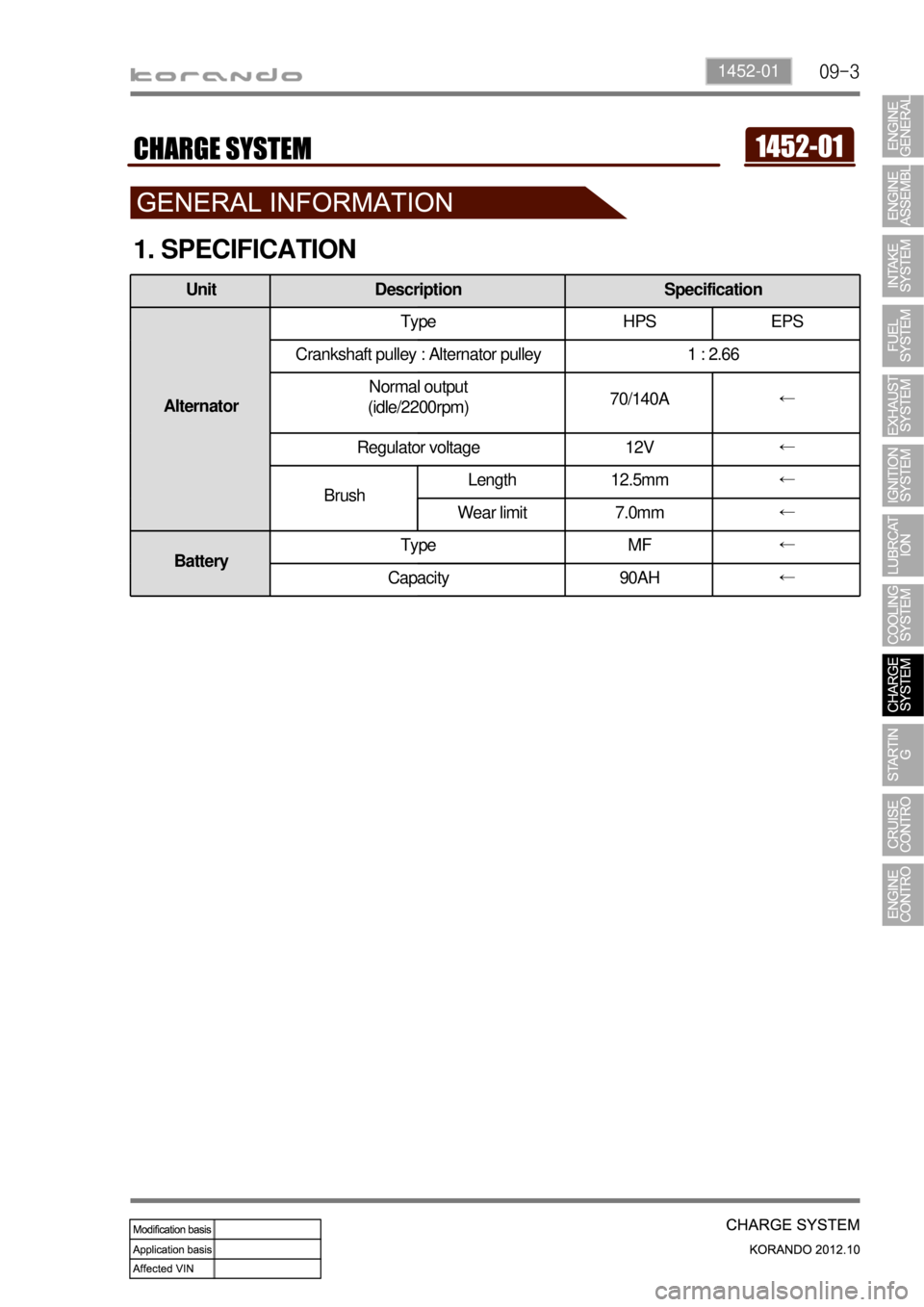
09-31452-01
1. SPECIFICATION
Unit Description Specification
AlternatorType HPS EPS
Crankshaft pulley : Alternator pulley 1 : 2.66
Normal output
(idle/2200rpm)70/140A←
Regulator voltage 12V←
BrushLength 12.5mm←
Wear limit 7.0mm←
BatteryType MF←
Capacity 90AH←
Page 445 of 1082

09-91452-01
Using battery tester ▶
PASS (11.0 V or more): Explain to the customer that the battery is reusable.
Need to be charged (9.0 to 11.0 V): Charge the battery with a charger and reinstall it. Explain it to the
customer.
Need to be replaced (9.0 V or more): The battery should be replaced due to overdischarging. -
-
-
How to use battery tester ▶
Determine battery capacity by fixing current
(load capacity) and time and varying voltage.
Determine battery capacity based on the
amount of voltage drop when discharging a
fixed load capacity (120 A) for 5 seconds.
Connect the tester to the battery and read the
display while applying a load for 5 seconds. -
-
-
Red area (①): overdischarge or faulty
battery
Yellow area (②): Need to be charged
(using a vehicle alternator and a battery
charger)
Green area (③): Normal
Red area on the left-hand side of OK (④):
Impossible to charge with an alternator
Green area with OK (⑤): Normally charged
Red area on the right-hand side of OK
(⑥): Overcharged by an alternator -
-
-
-
-
-
-
Page 495 of 1082

01-70000-00
Brake Master cylinder type Tandem type
Booster type Vacuum assisted booster type
Brake type Front wheel Disc
Rear wheel Disc
Parking brake Mechanical type
Suspension Front suspension MacPherson + Coil spring
Rear suspension Multi-link + Coil spring
Air
ConditionerRefrigerant (capacity)
R-134a(430 ± 30g)
Electrical Battery type / Capacity (V-AH) MF / 12 - 90
Starter capacity (V-KW) 12 - 2.3
Alternator capacity (V-A) 14V-140A (EPS), 14V-120A (NPS)
* ( ) option
DescriptionDiesel 2.0 Engine
(D20DTF(Low CO2))
Manual
TransaxleOperating type Floor change type
Gear ratio 1st 3.385
2nd 1.708
3rd 1.033
4th 0.786
5th 0.730
6th 0.595
Reverse 3.747
Transfer Case Model 4WD
Type Electronic control type
Clutch Operating type Hydraulic type
Disc type Dry single diaphragm type
Power
SteeringType Rack and pinion
Steering angle Inner39.0°
Outer31.24°
Rear Axle Drive shaft type Independent
suspensionBall joint type (4WD)
Axle housing type Build-up type (4WD)
Page 509 of 1082
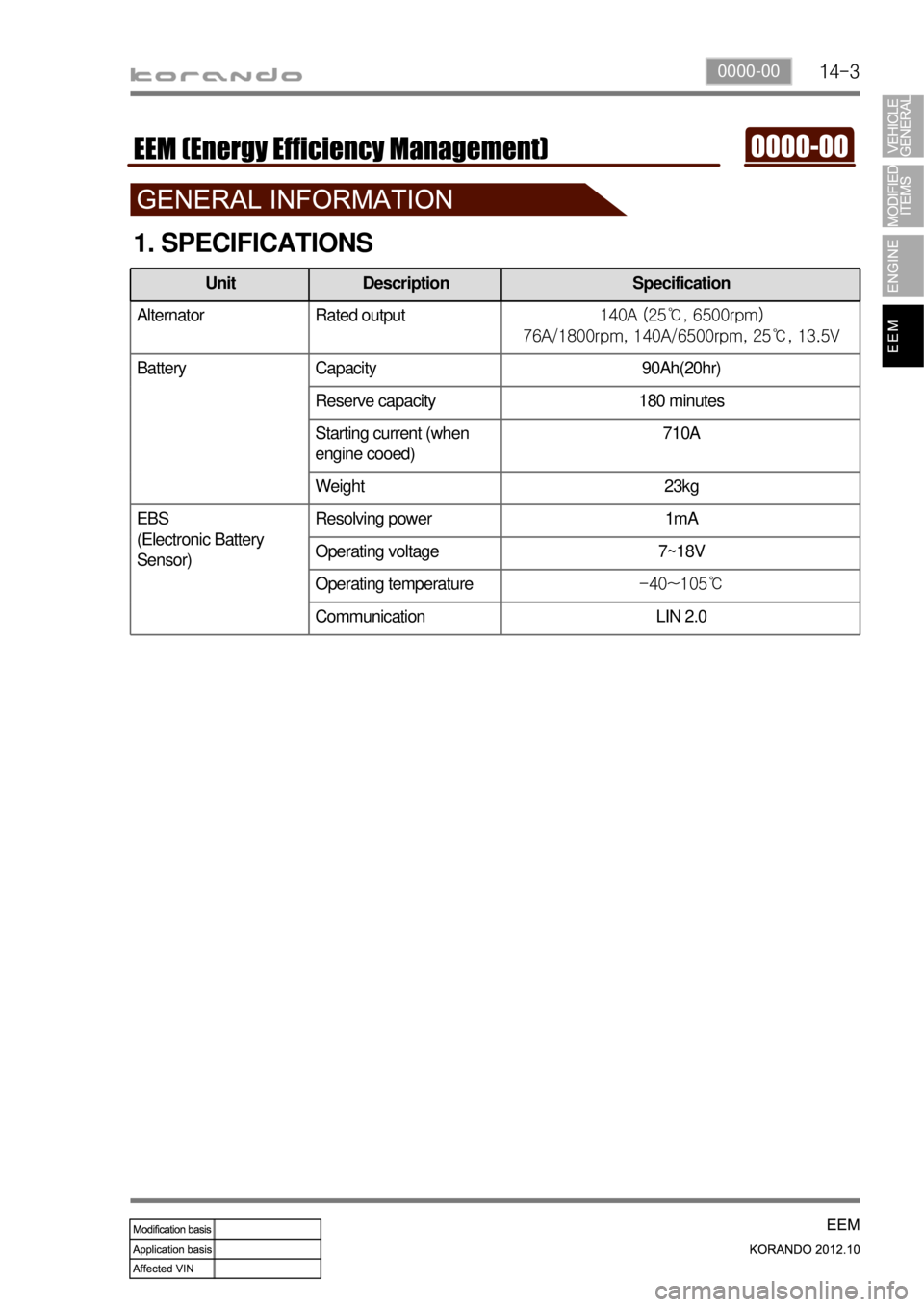
14-30000-00
1. SPECIFICATIONS
Alternator Rated output140A (25℃, 6500rpm)
76A/1800rpm, 140A/6500rpm, 25℃, 13.5V
Battery Capacity 90Ah(20hr)
Reserve capacity 180 minutes
Starting current (when
engine cooed)710A
Weight 23kg
EBS
(Electronic Battery
Sensor)Resolving power 1mA
Operating voltage 7~18V
Operating temperature-40~105℃
Communication LIN 2.0
Unit Description Specification
Page 510 of 1082

14-4
2. COMPARISON
ItemDescription
D20DTF D20DTF (Low CO2)
Effective date From March, 2012
Applied engine D20DTF
Battery capacity 12V 90Ah
Alternator capacity Delphi 120A Delphi 140A
AlternatorChanged the diameter of belt pulley (Front view)
Changed the regulator and control logic (Rear view)
ECU Without EEM logic With EEM logic
EBS NoneMonitoring the battery conditions (voltage,
current, temperature and SOC)
Page 520 of 1082
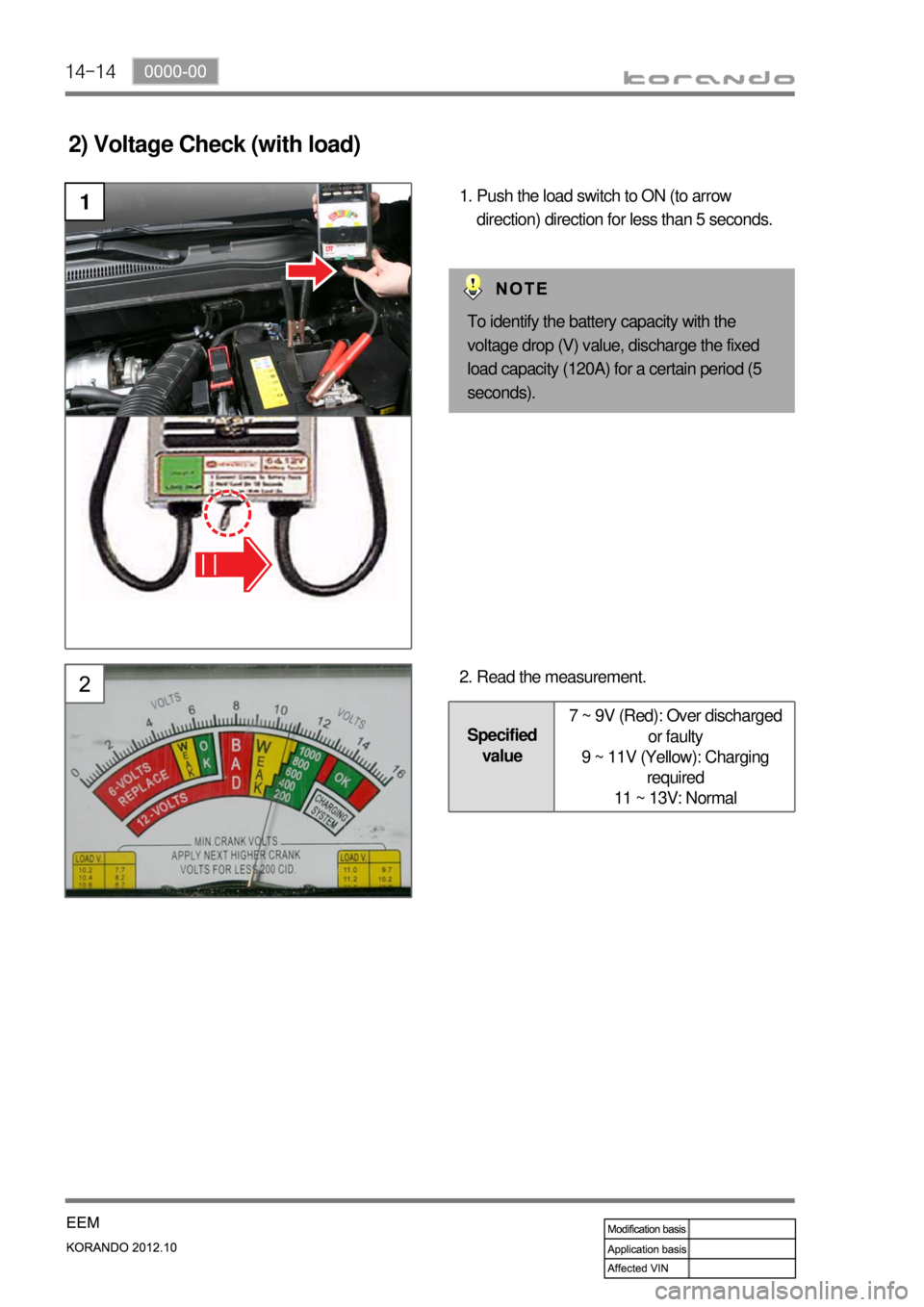
14-14
2) Voltage Check (with load)
1Push the load switch to ON (to arrow
direction) direction for less than 5 seconds. 1.
Read the measurement. 2.
Specified
value7 ~ 9V (Red): Over discharged
or faulty
9 ~ 11V (Yellow): Charging
required
11 ~ 13V: Normal
To identify the battery capacity with the
voltage drop (V) value, discharge the fixed
load capacity (120A) for a certain period (5
seconds).